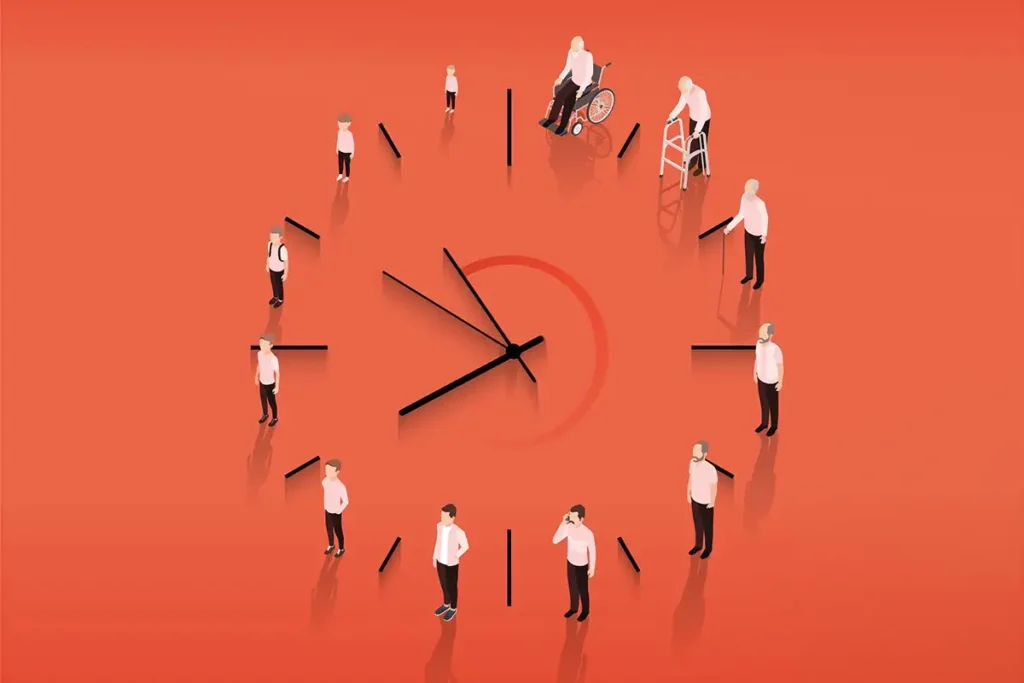The concept of reverse aging has intrigued scientists and skincare enthusiasts alike for years. Aging is a natural process, recent advancements in science and skincare suggest that some aspects of aging might be slowed down, or even reversed. Aging is a complex biological process characterized by the gradual decline in physiological functions and the increased susceptibility to diseases. Through targeted treatments, lifestyle changes, and cutting-edge research, it’s becoming increasingly possible to reduce visible signs of aging and restore a youthful appearance. However, the question remains: can we truly turn back the clock, or is it about aging gracefully with the right tools? Understanding the science of aging involves examining the cellular and molecular mechanisms that drive this process. Here, we delve into the science behind aging and the promising avenues for its potential reversal.
Disclosure: As an Amazon Associate, we earn from qualifying purchases through affiliate links.
The Science of Aging: Promising Avenues for Reversing the Clock
Reversing the Aging Process: What Biology Tells Us
- Cellular Senescence: One of the hallmarks of aging is cellular senescence, where cells lose their ability to divide and function properly. This phenomenon is driven by telomere shortening, DNA damage, and oxidative stress.
- Telomeres and Telomerase: Telomeres are protective caps at the ends of chromosomes that shorten with each cell division. When they become too short, cells enter senescence or die. Telomerase, an enzyme that extends telomeres, can delay this process, offering a potential target for anti-aging therapies.
- Mitochondrial Dysfunction: Mitochondria are the powerhouses of cells, producing energy. Over time, mitochondrial function declines, leading to reduced energy production and increased oxidative stress, contributing to aging.
- Stem Cell Exhaustion: Stem cells are essential for tissue repair and regeneration. As we age, the number and function of stem cells decline, impairing the body’s ability to maintain and repair tissues.
- Epigenetic Changes: Aging is also associated with changes in gene expression without alterations in the DNA sequence, known as epigenetic changes. These can affect various cellular processes, contributing to the aging phenotype.
Reverse Aging: The Potential and Possibilities
- Telomere Extension: Research on telomerase activation has shown potential in extending the lifespan of cells. Studies in model organisms have demonstrated that extending telomeres can improve health and longevity.
- Senolytics: These are drugs that selectively eliminate senescent cells. By removing these dysfunctional cells, senolytics can reduce inflammation and improve tissue function, potentially reversing some aspects of aging.
- Mitochondrial Enhancement: Enhancing mitochondrial function through dietary supplements, such as NAD+ precursors (nicotinamide riboside), and lifestyle interventions can improve cellular energy production and reduce oxidative damage.
- Stem Cell Therapy: Replenishing the body’s stem cell reserves through transplantation or stimulating endogenous stem cells can rejuvenate tissues and improve regenerative capacity.
- Epigenetic Reprogramming: Techniques like Yamanaka factors, which are a set of transcription factors, have shown promise in reprogramming aged cells to a more youthful state. This approach is still in its experimental stages but offers exciting potential for reversing cellular aging.
The Quest to Reverse Aging: Science and Strategies
Aging is a natural and inevitable part of life, yet the quest to halt or reverse its effects has been a driving force in human culture for centuries. The desire to maintain youthfulness, vitality, and beauty spans across all civilizations and eras, reflecting our universal yearning for longevity and the preservation of health.
From Ancient Remedies to Modern Science: The History of Reverse Aging
The history of anti-aging is rich and varied, encompassing a wide range of practices, remedies, and scientific advancements. From ancient herbal concoctions to modern-day biotechnology, humanity’s efforts to combat aging have evolved significantly.
1. Ancient Civilizations and Early Remedies for Reverse Aging
- Ancient Egypt: One of the earliest recorded civilizations to explore anti-aging techniques, the Egyptians utilized a variety of natural ingredients. Cleopatra, the iconic queen, was known for her milk baths, which were believed to keep her skin soft and youthful. Ingredients like honey, olive oil, and aloe vera were commonly used for their moisturizing and healing properties.
- Related Blog: Egyptian Milk Bath The Secrets Around the Earth – Top 5 Picks
- Ancient China: Traditional Chinese medicine has long emphasized longevity and the preservation of youth. Practices such as acupuncture, herbal medicine, and tai chi were developed to balance the body’s energy and promote long life. Pearl powder, ginseng, and green tea were among the prized substances for maintaining youthful skin and vitality.
Related Blog: Chinese Top 5 Jade Roller Ancient Secrets for Younger Skin - Ancient Greece and Rome: Greek and Roman societies were also deeply invested in the pursuit of youth. The Greeks, particularly, were known for their rigorous beauty regimens, including the use of olive oil for skin care. Roman baths, combined with the application of various botanical extracts, were a cornerstone of Roman beauty rituals.
Related Blog: The Power of Greek Yogurt and Honey- 5 Top Picks for Luxurious Skin - Ancient Brazil: In Brazil, Coffee has been a vital part of Brazilian culture for centuries, both as a beverage and as a skincare ingredient. The use of coffee in beauty treatments is a testament to the resourcefulness and innovation of traditional Brazilian skincare practices. These scrubs are often used in spas and home treatments across Brazil, valued for their ability to enhance the skin’s appearance and texture naturally.
- Related Blog: Brazilian Coffee Scrub: 5 Top Picks – A Traditional Beauty Hack
- Ancient French: Ancient French Green Clay Powder, also known as Sea Clay, is a natural substance sourced from ancient sea beds in France. Basically, green clay is composed of various minerals, including montmorillonite and illite, which contribute to its unique green color and beneficial qualities. This beauty secret hacks has been used for centuries in skincare due to its powerful detoxifying, exfoliating, and healing properties.
Related Blog: 7 Best French Green Clay Powder- Beauty Secret Hacks - Ancient Morocco: Argan oil has a deep-rooted cultural significance in Morocco, often referred to as “liquid gold,” is a precious oil extracted from the kernels of the argan tree (Argania spinosa) native to Morocco. It is renowned for its rich content of essential fatty acids, antioxidants, vitamins, and minerals, making it a versatile and highly prized ingredient in skincare, hair care, and culinary uses. Traditionally, Berber women have used it for centuries for its culinary and cosmetic benefits.
Related Blog: Top 8 Moroccan Argan Oil: The Liquid Gold – A Luxurious Gift from Earth - Ancient India: Turmeric holds a significant place in Indian culture, particularly in beauty rituals and ceremonies. It is often used in bridal beauty regimens to impart a radiant glow to the bride’s skin before the wedding day. Known as the “Haldi” ceremony, this practice symbolizes purity, auspiciousness, and the beginning of a new chapter. Turmeric, a vibrant yellow spice derived from the root of the Curcuma longa plant, is known for its potent anti-inflammatory, antioxidant, and antimicrobial properties.
Related Blog: Indian Turmeric Mask- Unveil Top 7 Turmeric Skincare Products - Ancient Japan: Japanese Rice Water is a centuries-old beauty secret used by Japanese women to achieve smooth, radiant, and youthful-looking skin. Rice water, the milky liquid left over after soaking or cooking rice, is rich in vitamins, minerals, and antioxidants that nourish and rejuvenate the skin. This natural remedy has been passed down through generations and remains a popular skincare practice in Japan.
Related Blog: 7 Must-Have Japanese Rice Water Beauty Hacks: Top Skin Care & Hair Care Products - Ancient Korea: Korean double cleansing has long been a cornerstone of skincare hacks, particularly in the quest for youthful, ageless skin. This traditional method, which involves using an oil-based cleanser followed by a water-based cleanser, thoroughly removes makeup, dirt, and impurities while ensuring the skin remains balanced and hydrated. By deeply purifying the skin, it allows anti-aging treatments to penetrate more effectively, helping to prevent wrinkles and maintain a smooth, glowing complexion.
Related Blog: Korean Double Cleansing Ritual: Top 7 Products- A Timeless Beauty Secret
2. Medieval and Renaissance Approaches for Reverse Aging
During the medieval period, the quest for eternal youth often intersected with alchemy and early medical science. Alchemists sought the elusive “elixir of life” and “philosopher’s stone,” believed to grant immortality. Though these efforts were more mystical than scientific, they laid the groundwork for future explorations into chemistry and medicine.
3. Modern Era and Scientific Advancements for Reverse Aging
The 20th and 21st centuries have seen unprecedented advancements in our understanding of aging and how to combat it. Scientific research has identified key factors contributing to aging, such as cellular damage, oxidative stress, and genetic influences. This knowledge has led to the development of sophisticated anti-aging treatments and products.
- Cosmetic Innovations: The cosmetic industry has exploded with products designed to reduce the visible signs of aging. Ingredients like retinoids, hyaluronic acid, peptides, and antioxidants are now staples in anti-aging skincare, offering scientifically backed benefits.
- Check this: 11 Best Anti-Aging Moisturizers for All Skin Types
- Medical Interventions: Medical advancements have introduced procedures like Botox, dermal fillers, and laser treatments that can significantly reduce the appearance of wrinkles and other age-related changes. More invasive procedures, such as face-lifts and other forms of plastic surgery, offer dramatic results.
- Genetic and Cellular Research: Cutting-edge research in genetics and cellular biology is paving the way for groundbreaking anti-aging therapies. Telomere research, for example, explores how chromosome end structures influence aging, while stem cell therapy holds promise for regenerating aged tissues.
The Journey to Reverse Aging
The journey to reverse aging is far from over. As science continues to advance, the possibility of significantly slowing down or even reversing certain aspects of aging becomes more realistic. With ongoing research into genetics, regenerative medicine, and biotechnology, the future of anti-aging holds exciting potential. For now, incorporating effective anti-aging secrets and solutions practice into daily routines can help maintain youthful, healthy skin and overall well-being. Using high-quality moisturizers, protecting the skin from sun damage, maintaining a healthy diet, and leading an active lifestyle are all crucial components of an anti-aging regimen. Explore to find the perfect product for your skin type and take the next step in your anti-aging journey. Embrace the history, science, and future of anti-aging, and unlock the secrets to looking and feeling your best at any age.
The Fundamentals of Aging
To effectively combat aging, it’s essential to understand the underlying factors that contribute to the visible signs of aging. These include:
- Cellular Damage: Over time, cells accumulate damage from environmental factors like UV radiation and pollution, leading to signs of aging such as wrinkles and pigmentation.
- Oxidative Stress: Free radicals, unstable molecules that damage cells, play a significant role in the aging process. Antioxidants help neutralize these free radicals.
- Genetic Factors: Genetics influence how quickly our skin shows signs of aging, including factors like collagen production and skin elasticity.
- Lifestyle Choices: Diet, exercise, smoking, and alcohol consumption significantly impact the skin’s health and aging process.
Conclusion
In conclusion, “Reverse Aging: Breakthroughs in Anti-Aging Science” highlights the remarkable progress made in our understanding and approach to aging. With cutting-edge research and innovative treatments, the dream of reversing aging is becoming increasingly attainable. From cellular rejuvenation to advanced gene therapy, these scientific advancements offer promising potential to not only slow down the aging process but also to restore youthful vitality. As we continue to explore these breakthroughs, the future of anti-aging science holds the promise of a longer, healthier, and more vibrant life for all. Combating the signs of aging requires a holistic approach that includes using high-quality skincare products, making healthy lifestyle choices, and incorporating advanced treatments as needed. By understanding the fundamental causes of aging and utilizing these proven solutions, you can maintain a youthful, radiant complexion.
To stay informed about the latest advancements in anti-aging and best product recommendation explore our detailed guides. Embrace the journey of scientific discovery and unlock the potential for a youthful, vibrant future.



